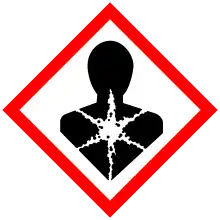| Names | |
|---|---|
| IUPAC name
Cobalt(III) hydroxide | |
| Other names
Cobaltic hydroxide | |
| Identifiers | |
3D model (JSmol) |
|
| ChemSpider | |
| ECHA InfoCard | 100.013.776 |
| EC Number |
|
PubChem CID |
|
| UNII | |
CompTox Dashboard (EPA) |
|
| |
| |
| Properties | |
| Co(OH)3 | |
| Molar mass | 109.95522 g |
| Appearance | brown-black or dark green powder |
| Hazards | |
| GHS labelling: | |
  | |
| Danger | |
| H319, H334, H413 | |
| P261, P264, P273, P280, P285, P304+P341, P305+P351+P338, P337+P313, P342+P311, P501 | |
Except where otherwise noted, data are given for materials in their standard state (at 25 °C [77 °F], 100 kPa).
Infobox references | |
Cobalt(III) hydroxide or cobaltic hydroxide is a chemical compound with formula Co(OH)
3 or H
3CoO
3. It is an ionic compound, with trivalent cobalt cations Co3+
and hydroxyl anions OH−
.
The compound is known in two structurally different forms, "brownish-black" and "green". The brownish-black form is a stable solid and can be prepared by reaction of water solutions of cobalt(II) chloride and sodium hydroxide, followed by oxidation with ozone.[1]
The green form, formerly thought to be cobalt(II) peroxide, apparently requires carbon dioxide as a catalyst. It can be prepared by adding hydrogen peroxide to a solution of cobalt(II) chloride in 96% ethanol at –30 to –35°C, then adding a 15% solution of sodium carbonate in water with intense stirring. The resulting dark green powder is fairly stable at liquid nitrogen temperature, but at room temperature it turns dark brown within a few days.[2]
Natural occurrence
As of 2020, Cobalt(III) hydroxide is unknown among the known mineral species. However, heterogenite, CoO(OH), is known.[3][4]
See also
- Cobalt(II) hydroxide Co(OH)
2 - Cobalt(III) oxyhydroxide CoO(OH)
References
- ↑ Pankratov, D.A., Veligzhanin, A.A., and Zubavichus, Y.V. (2013): "Structural Features of Green Cobalt(III) Hydroxide". Russian Journal of Inorganic Chemistry, volume 58, issue 1, pages 67–73. doi:10.1134/S0036023613010142
- ↑ Pankratov, D.A., Portachenko, T.A., and Perfil’ev, Y.D. (2008): "Emission Mössbauer Study of 'Cobalt Peroxide'". Moscow University Chemical Bulletin, volume 63, issue 5, pages 292–296. doi:10.3103/S002713140805012X
- ↑ "Heterogenite".
- ↑ "List of Minerals". 21 March 2011.